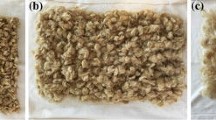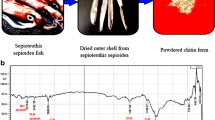Abstract
An innovative approach of using a laboratory embossing prototype was carried out to develop and optimize tissue papers, to quantify the influence of “deco” and “micro” embossing. A comparison between non-embossed and embossed tissue papers was conducted to investigate the effect of this process, on industrial and laboratory-made structures, evaluated by mechanical and softness properties. To identify the influence of the embossing patterns, the fiber composition and the creping process, a creped industrial base tissue paper, a disintegrated fibrous suspension obtained from this one, and an industrial never-dried bleached eucalyptus kraft pulp, were used as samples. These last two materials were used to produce similar industrial base tissue paper, in other words, handsheets with a grammage of 17 g/m2 and unpressed. The end-use tissue properties were evaluated on the non-embossed and embossed structures. The results indicated that the embossing process produced bulkier and more porous structures, at the expense of reduced mechanical and softness properties, more intensified in the “micro” embossing than in the “deco” embossing. The effect of fiber composition shows that the mechanical properties were increased with an adverse effect on the structures' TSA-softness. Furthermore, these properties are enhanced for the structures where creping process effects are presents. The performance of structures with and without embossing allowed to quantify the functional properties of softness and strength, combining ISO experimental methods and computational approaches that benefit from modeling strategies considering its structural hierarchy at the fiber and structure levels, and the shape pattern used in the embossing process. Finite Element Model (FEM) analysis enabled a better understanding of how the embossing patterns affect the mechanical properties during the embossing process. The experimental results were validated using FEM simulation, which proved that “micro” pattern has a higher stress field value, and consequently a lower mechanical strength. Overall, the results indicate that the embossing prototype can be used as an opportunity to investigate the embossing process at laboratory scale and to optimize the final end-use tissue properties due to the controlled process parameters implemented in this methodology.













Similar content being viewed by others
Data availability
The raw/processed data required to reproduce the above findings cannot be shared at this time as the data also forms part of an ongoing study.
References
Anukul P, Khantayanuwong S, Somboon P (2015) Development of laboratory wet creping method to evaluate and control pulp quality for tissue. Tappi J 14(5):339–345
Axelsson B (2001) Pulp for high absorption tissue products. Pap Technol 42(7):24–26
Bai B, Folorunso M, Berglund M (2019) Perceived vs recorded quality of tissue paper. Master’s Thesis, Linköping University, Linköping, Östergötland, Sweden
Boudreau J, Germgård U (2014) Influence of various pulp properties on the adhesion between tissue paper and Yankee cylinder surface. BioResources 9(2):2107–2114. https://doi.org/10.15376/biores.9.2.2107-2114
Costa VLD, Costa AP, Amaral ME, Oliveira C, Gama M, Dourado F, Simões RM (2016) Effect of hot calendering on physical properties and water vapor transfer resistance of bacterial cellulose films. J Mater Sci 51:9562–9572. https://doi.org/10.1007/s10853-016-0112-4
Crescent Former, or Conventional, Tissue Machine Technology|The Tissue Story (2017)
Curto JMR, Conceição ELT, Portugal ATG, Simões RMS (2011) Three dimensional modeling of fibrous materials and experimental validation. Materwiss Werksttech 42:370–374. https://doi.org/10.1002/mawe.201100790
de Assis T, Reisinger L, Pal L, Pawlak J, Jameel H, Gonzalez R (2018) Understand the effect of machine technology and cellulosic fibers on tissue properties—a review. BioResources 13(2):4593–4629. https://doi.org/10.15376/biores.13.2.DeAssis
DeMaio A, Patterson T (2008) Similarities in bonding influence between pre-failure tensile creep and stress–strain behavior of paper. Mech Mater 40(3):133–149. https://doi.org/10.1016/j.mechmat.2007.06.007
Digby, P. “pd-Tissues - Trees to Paper” (2012) http://pd-tissues.co.uk/trees-to-paper.aspx Accessed 13 Feb 2019
Conceição ELT, Curto JMR, Simões RMS, Portugal ATG (2010) Coding a simulation model of the 3D structure of paper. In: Barneva RP, Brimkov VE, Hauptman HA, Natal Jorge RM, Tavares JMRS (eds) Computational modeling of objects represented in images, CompIMAGE 2010. Lecture notes in computer science. Springer, Berlin, pp 299–310. https://doi.org/10.1007/978-3-642-12712-0_27
Fišerová M, Gigac J, Stankovská M, Opálená E (2019) Influence of bleached softwood and hardwood kraft pulps on tissue paper properties. Cellul Chem Technol 53(5–6):469–477. https://doi.org/10.35812/CelluloseChemTechnol.2019.53.47
Giacomozzi DE, Joutsimo O (2015) Drying temperature and hornification of industrial never-dried Pinus Radiata Pulps. 1. Strength, optical, and water holding properties. Bioresources 10(3):5791–5808. https://doi.org/10.15376/biores.10.3.5791-5808
Henriksson M, Berglund LA, Isaksson P, Lindström T, Nishino T (2008) Cellulose nanopaper structures of high toughness. Biomacromol 9:1579–1585. https://doi.org/10.1021/bm800038n
Hilbig K, Liplijn M, Reinheimer H (2005) Method of making a thick and smooth embossed tissue. Cincinnati, OH (2005)
Hollmark H (1984) Mechanical properties of tissue. In: Handbook of physical and mechanical testing of paper and paperboard, New York, pp 497–521
ISO 187:1990 Paper, board and pulps—Standard atmosphere for conditioning and testing and procedure for monitoring the atmosphere and conditioning of samples (1990) INTERNATIONAL STANDARD ISO.
ISO 5263-1:1995 Pulps—Laboratory wet disintegration (1995) INTERNATIONAL STANDARD ISO
ISO 5269-1:1998 Pulps — Preparation of laboratory sheets for physical testing—Part 1: Conventional sheet-former method (1998) INTERNATIONAL STANDARD ISO
ISO 5267-1:1999 Pulps — Determination of drainability—Part 1: Schopper-Riegler method. (1999) INTERNATIONAL STANDARD ISO
ISO 12625-4:2005a Tissue Paper and Tissue Products - Part 4: Determination of tensile strength, stretch at break and tensile energy absorption (2005a) INTERNATIONAL STANDARD ISO
ISO 12625-6:2005b Tissue Paper and Tissue Products - Part 6: Determination of Grammage (2005b) INTERNATIONAL STANDARD ISO.
ISO 5351:2010 Pulps — Determination of limiting viscosity number in cupri-ethylenediamine (CED) solution (2010) INTERNATIONAL STANDARD ISO.
ISO 12625-3:2014 Tissue Paper and Tissue Products—Part 3: Determination of Thickness, Bulking Thickness and Apparent Bulk Density and Bulk (2014). INTERNATIONAL STANDARD ISO
ISO 48-7:2018 Rubber, vulcanized or thermoplastic—Determination of hardness—Part 7: Apparent hardness of rubber-covered rollers by Shore-type durometer method” (2018) INTERNATIONAL STANDARD ISO
Lofink B (2003) Device for applying an embossing to a web of tissue paper. Justia Patents, USA, Patent Nº 6729869 (2003)
Mendes AO, Fiadeiro PT, Costa AP, Amaral ME, Belgacem MN (2015) Laser scanning for assessment of the fiber anisotropy and orientation in the surfaces and bulk of the paper. Nord Pulp Pap Res J 30(2):308–318. https://doi.org/10.3183/npprj-2015-30-02-p308-318
Mendes AO, Fiadeiro PT, Costa AP, Amaral ME, Belgacem MN (2013) Retro-diffusion and transmission of laser radiation to characterize the paper fiber distribution and mass density. In: Proceedings Volume 8785: 8th Ibero American optics meeting and 11th latin american meeting on optics, lasers, and applications, Porto, Portugal, pp 8785AY-1/8785AY-8. https://doi.org/10.1117/12.2022367
Mendes AO, Fiadeiro PT, Costa AP, Amaral ME, Belgacem MN (2014). “Study of repeatability of an optical laser system for characterization of the paper fiber distribution and mass density. In: Proceedings Volume 9286: second international conference on applications of optics and photonics, Aveiro, Portugal, pp 92862Y-1/92862Y-8. https://doi.org/10.1117/12.2062697
Morais FP, Bértolo RAC, Curto JMR, Amaral MECC, Carta AMMS, Evtyugind DV (2019) Comparative characterization of eucalyptus fibers and softwood fibers for tissue papers applications. Mater. Lett. X 4:100028. https://doi.org/10.1016/j.mlblux.2019.100028
Morais FP, Carta AMMS, Amaral ME, Curto JMR (2020a) 3D fiber models to simulate and optimize tissue materials. BioResources 15:8833–8848. https://doi.org/10.15376/biores.15.4.8833-8848
Morais FP, Carta AMMS, Amaral ME, Curto JMR (2020b) Experimental 3D fibre data for tissue papers applications. Data Brief 30:105479. https://doi.org/10.1016/j.dib.2020.105479
Morais FP, Vieira JC, Mendes AO, Carta AM, Costa AP, Fiadeiro PT, Curto JMR, Amaral ME (2022) Characterization of absorbency properties on tissue paper materials with and without “Deco” and “Micro” embossing patterns. Cellulose. https://doi.org/10.1007/s10570-021-04328-1
Park NY, Ko YC, Melani L, Kim HJ (2020) Mechanical properties of low-density paper. Nord Pulp Pap Res J 35(1):61–70. https://doi.org/10.1515/npprj-2019-0052
Ramasubramanian MK, Sun Z, Chen G (2011) A mechanics of materials model for the creping process. J Manuf Sci Eng 133(5):051011. https://doi.org/10.1115/1.4004925
Sihtola H, Kyrklund B, Laamanen L, Palenius L (1963) Comparison and conversion of viscosity and DP values by different methods. Pap Puu 45(4a):225–232
Silvy J, Romatier G, Chiodi R (1968) Méthodes pratiques de controle du raffinage. ATIP 22:31–53
Sjöholm E, Gustafsson K, Norman E, Colmsjö A (1997) The effect of degradation on the strenght of hardwood kraft pulp fibers. In: Proceedings of the 9th international symposium wood and pulping chemistry, Montréal, vol 106, pp 1–4
Skapa. Roll covers for the paper industry (2020) http://vit-group.com/skapa/test/download/Produktprospekt_GB.pdf. Accessed 21 Oct. 2020
Spina R, Cavalcante B (2018) Characterizing materials and processes used on paper tissue converting lines. Mater Today Commun 17:427–437. https://doi.org/10.1016/j.mtcomm.2018.10.006
Stankovská M, Gigac J, Fišerová M, Opálená E (2020) Blending impact of hardwood pulps with softwood pulp on tissue paper properties. Wood Res 65:447–458. https://doi.org/10.37763/wr.1336-4561/65.3.447458
TAPPI T237 cm-08 Carboxyl Content of Pulp. Technical Association of the Pulp and Paper Industry (2008)
Tourtollet GEP, Cottin F, Cochaux A, Petit-Conil M (2003) The use of MorFi analyser to characterise mechanical pulps, Quebec City, Canada
Vieira JC, de Oliveira Mendes A, Carta AM, Galli E, Fiadeiro PT, Costa AP (2020) Impact of embossing on liquid absorption of toilet tissue papers. BioResources 15(2):3888–3898. https://doi.org/10.15376/biores.15.2.3888-3898
Wang Y, Assis TD, Zambrano F, Pal L, Venditti R, Dasmohapatra S, Pawlak J, Gonzalez R (2019) Relationship between human perception of softness and instrument measurements. BioResources 14(1):780–795. https://doi.org/10.15376/biores.14.1.780-795
Acknowledgments
The authors would like to also thank the company PCE Iberica S.L. Instrumentacíon for the donation of the Durometer PCE-DDA equipment that was used in this work to determine the apparent hardness of the rubber rollers. Finally, the authors acknowledge the materials, access to equipment and installations, and all the general support given by The Navigator Company, RAIZ, and the Optical Center, Department of Physics, Department of Textile Science and Technology, and Department of Chemistry of the Universidade da Beira Interior.
Funding
The authors gratefully acknowledge the funding of this work that was carried out under the Project InPaCTus – Innovative Products and Technologies from Eucalyptus, Project Nº 21874 funded by Portugal 2020 through European Regional Development Fund (ERDF) in the frame of COMPETE 2020 nº 246/AXIS II/2017. The authors are very grateful for the support given by research unit Fiber Materials and Environmental Technologies (FibEnTech-UBI), on the extent of the project reference UIDB/00195/2020, funded by the Fundação para a Ciência e a Tecnologia, IP/MCTES through national funds (PIDDAC).
Author information
Authors and Affiliations
Corresponding author
Ethics declarations
Conflict of interest
The author(s) declare(s) that they have no competing interests.
Additional information
Publisher's Note
Springer Nature remains neutral with regard to jurisdictional claims in published maps and institutional affiliations.
Rights and permissions
About this article
Cite this article
Vieira, J.C., Morais, F., de Oliveira Mendes, A. et al. Mechanical and softness characterization of “deco” and “micro” embossed tissue papers using finite element model (FEM) validation. Cellulose 29, 5895–5912 (2022). https://doi.org/10.1007/s10570-022-04618-2
Received:
Accepted:
Published:
Issue Date:
DOI: https://doi.org/10.1007/s10570-022-04618-2




